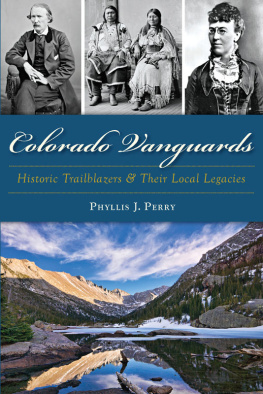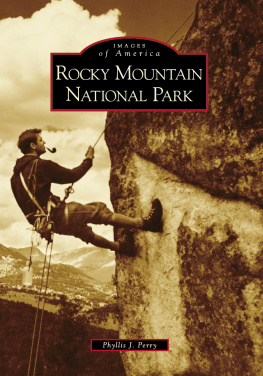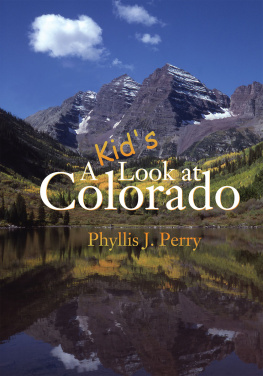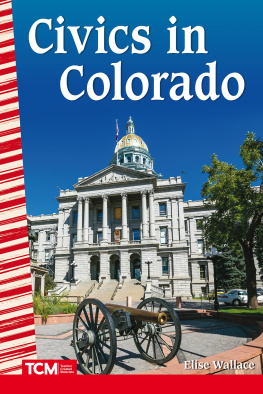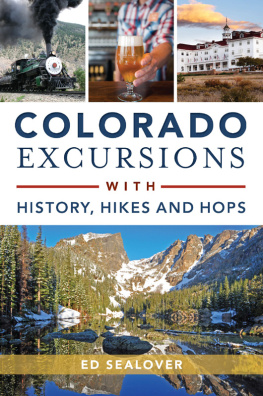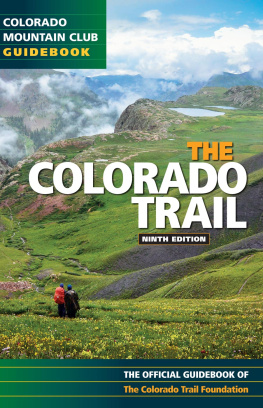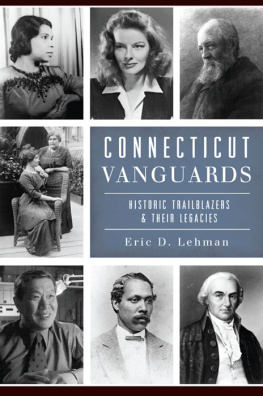


Published by The History Press
Charleston, SC
www.historypress.net
Copyright 2015 by Phyllis J. Perry
All rights reserved
First published 2015
e-book edition 2015
ISBN 978.1.62585.693.7
Library of Congress Control Number: 2015949880
print edition ISBN 978.1.46711.937.5
Notice: The information in this book is true and complete to the best of our knowledge. It is offered without guarantee on the part of the author or The History Press. The author and The History Press disclaim all liability in connection with the use of this book.
All rights reserved. No part of this book may be reproduced or transmitted in any form whatsoever without prior written permission from the publisher except in the case of brief quotations embodied in critical articles and reviews.
For David and Casey, who make the impossible possible.
Contents
Foreword
We see their names everywhere, and not just in Colorado: Baby Doe Tabor, Kit Carson, Zebulon Pike, Chief Ouray, Nikola Tesla, and Florence Sabin. And who doesnt recognize the name of Adolph Coors? But what many people dont realize is just how important these individuals and many others, who arguably are less well known, were to the development of Colorado.
One definition of vanguard reads, the foremost or leading position in a trend or movement. And Colorados leaders were as grand as the Rocky Mountains, from Zebulon Pike, who more than two centuries ago spotted a mountain that he called Grand Peak that now bears his name, to Enos Mills, known as the Father of Rocky Mountain National Park, whose lectures, photographs and books ensured that land was set aside for national parks.
Their motivations for taking on the challenge of exploring or living in Colorado, mostly in the 1800s, varied widely. Some, such as Zebulon Pike, Stephen Long, Jim Bridger and Kit Carson, were seasoned explorers. Jim Beckwourth, Charles Bent and William Bent sought adventure and fortune. Todays entrepreneurs would admire the restlessness of Uncle Dick Wootton, who couldnt resist establishing new businesses from stores to a saloon and a hotel, eventually establishing a tollgate for the toll road over Raton Pass right in front of his home.
Because of the times, many of the trappers and explorers also became competent fighters, whether serving in the army or defending a fort or settlement during various hostilities. At the same time, many worked hard to have strong, peaceful (and financially beneficial) relationships with Native Americans. Black Kettle, Chief Left Hand and Chief Ouray worked tirelessly against insurmountable odds and heartbreaking circumstances to keep peace in a quickly changing landscape.
And then there were the women of Colorado. Lady Isabella Bird wasnt about to let her long hiking skirt get in the way of climbing Longs Peak or exploring the Estes Park area. Helen Hunt Jackson, an accomplished writer, came to Colorado Springs for her health and stayed to write about the shameful treatment of Native Americans by the government. Dont miss that chapter about the Tabors for a glimpse into the social and political mores of the time.
Readers of Colorado Vanguards: Historic Trailblazers and Their Local Legacies will recognize the fine scholarship that supports each chapter. They will also relish the grand storytelling that brings these people to life. Author Phyllis Perrys voice and her attention to detail set Colorado Vanguards apart from other offerings of its like. Each story is peppered with those kinds of facts that readers will be itching to share in social situations or around the water cooler: Did you know that Tesla Motors honors an inventor named Nikola Tesla? Did you know that Nikola Teslas father wanted him to join the clergy? That he had to sneak candles so he could read at night because his father thought reading wasnt good for his eyes? That he got involved with gambling as a young man? That he built the largest Tesla coil everin Colorado? That is the kind of irresistible reading found in this book.
Today, you can drive up to the Stanley Hotel in a Model X Tesla, have a Coors beer and toast your good health, thanks to F.O. Stanley, Nikola Tesla, Adolph Coors and Florence Sabin. In fact, that would be the perfect setting for reading this intriguing collection of stories about Colorados vanguard. And if you cant get to Colorados mountains right now, this book will take you there anyway.
SUZANNE BARCHERS, EDD
Introduction
Few driving along todays Colorado highwayswhether going to visit the Great Sand Dunes National Park near Mosca, to a Broncos game in the mile-high city of Denver, to the annual Peach Festival at Palisade or to the Shakespeare Festival on the University of Colorado campus in Boulderwould stop to reflect that only a few hundred years ago, there were no Americans in this vast land. It was empty except for Native Americans and the animals and vegetation that supported them.
The first chapter in this book details the explorations of Zebulon Pike that took place in 1806, when, for the first time, the American flag was raised within the boundaries of Colorado. Many other men and women would follow. Some blazed trails, trapped and traded, while others sought gold and silver. More and more came, creating towns and cities; establishing a state government; building railroads; working farms and ranches; developing mining, timber and other industries; or contributing through teaching, medicine, invention and the arts.
Although these remarkable people might not have been born in the Rocky Mountain Region, each of the men and women discussed in this book made a significant contribution to the Rocky Mountain West and is best remembered for an association with a specific geographic place. Pike was the first to gaze up at the peak that today bears his name, and another of Colorados towering mountains is named for Major Stephen Long, who in 1820 set forth on his Rocky Mountain expedition. Longs group was responsible for collecting, sketching and describing the plants and animals of this remarkable piece of the Louisiana Purchase. Towns began to flourish. El Pueblo, founded as a tiny fur trading center by James Beckwourth, grew into the city of Pueblo.
Charles and William Bent are associated with the trading fort that they both built and destroyed, the same fort where Kit Carson served as a scout and hunter. Uncle Dick Woottonalthough a trapper, trader, freighter and farmeris best remembered for charging a toll from those who traveled over his Raton Pass. John Gregory and George Jackson are typical of the miners who sought their fortunes in gold and silver in Clear Creek Canyon. Chief Niwot astonished the first visitors to present-day Boulder County by speaking to them in English. Through her writings, Isabella Bird immortalized her climb up Longs Peak with Rocky Mountain Jim. Helen Hunt Jackson not only wrote about the plight of Native Americans in California but also extolled the beauties of Colorado Springs.
Chief Ouray and Chipeta at the Los Pinos Agency worked for peace between Native Americans and new white settlers. Although he was one of the few to escape, Chief Black Kettle is linked with the infamous Sand Creek Massacre. All three of the Tabors provided stories of wealth and drama in Leadville and Denver. In 1873, three years before Colorado became a state, Adolph Coors founded his brewery in Golden. John L. Routt led the state as its first governor, while Casimiro Barela served as representative from Trinidad, speaking up for the needs of minorities.
Next page
